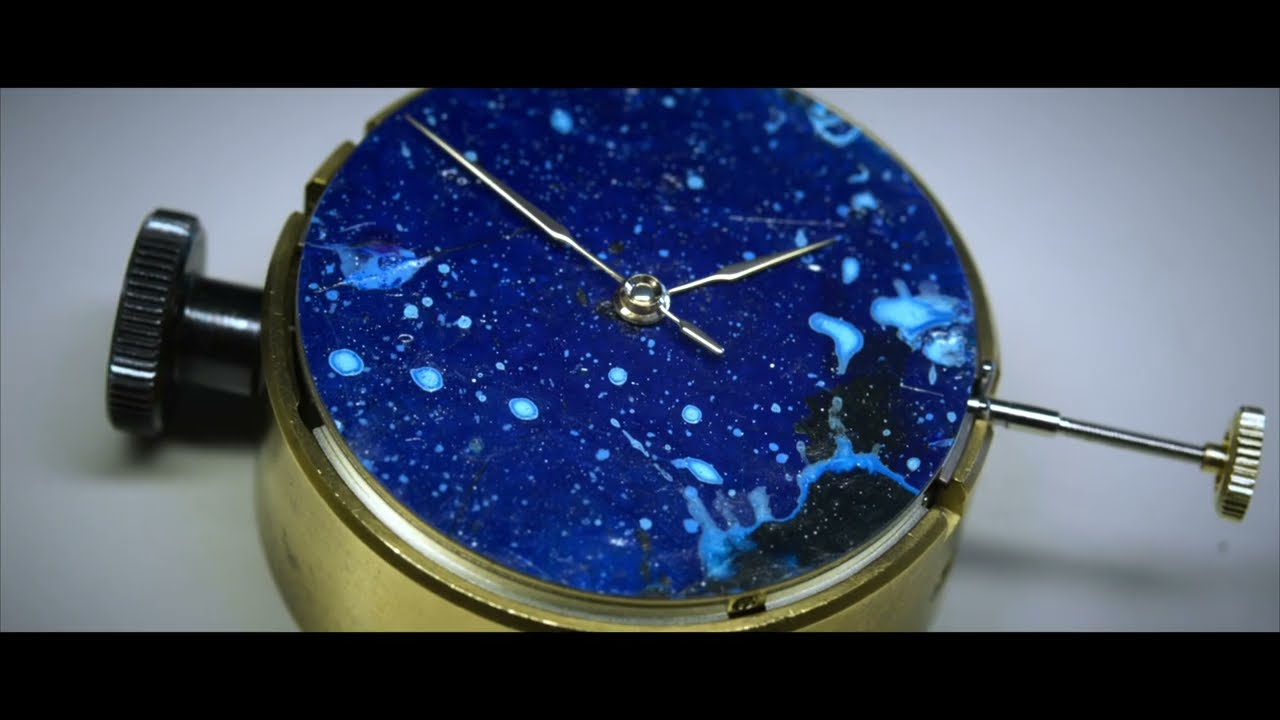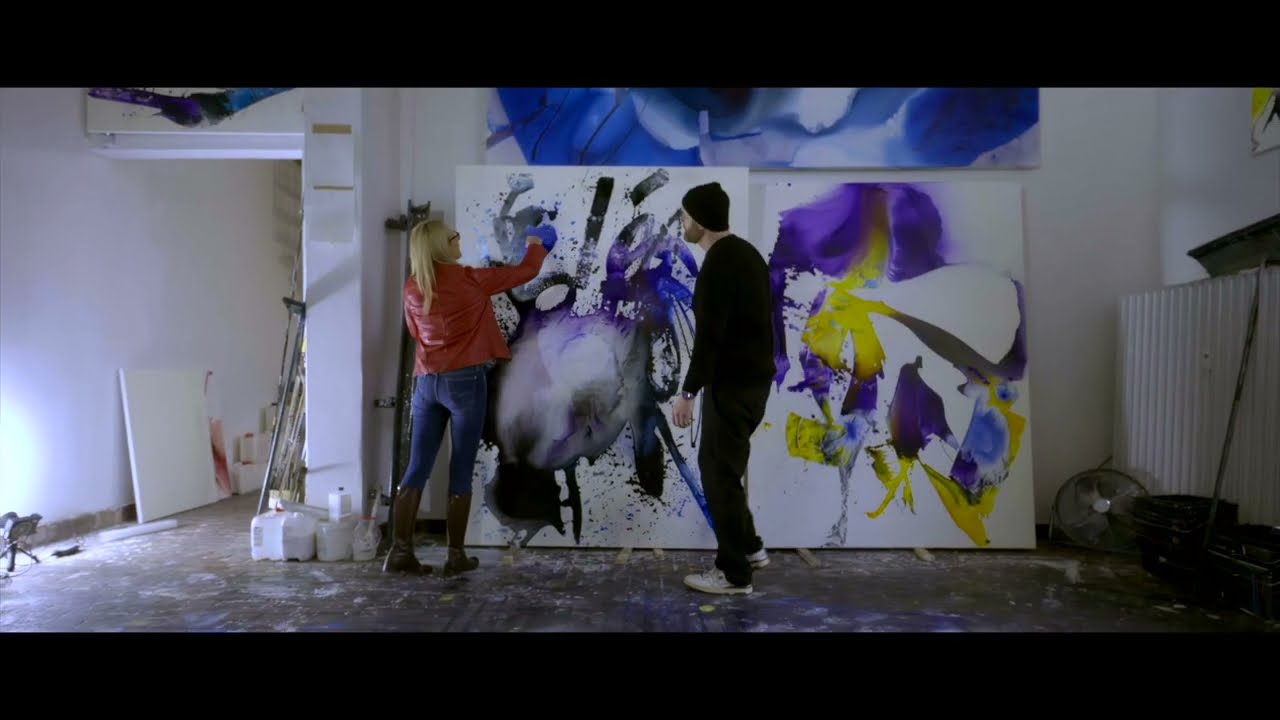As part of an exclusive collaboration with Düsseldorf painter Max Frintrop, the Glashütte watch manufactory Moritz Grossmann presents sixteen unique pieces in the ART EDITION Max Frintrop.
The Moritz Grossmann manufactory in Glashütte has been crafting the finest watches with intricate details and first-class quality since 2008. Together with German painter Max Frintrop, the company now unveils a spectacular special model in a strictly limited edition. Each of the sixteen one-of-a-kind pieces in the BENU ART EDITION Max Frintrop collection features a dial created using fragments of the intriguing and breathtakingly beautiful top layer of Max Frintrop’s studio floor – here, years of artistic expression have resulted in a mille-feuille of superimposed paint glazes reminiscent of geological substrates.

From a fleeting instant to eternity
Right from the very first prehistoric cave paintings, humans have used paint to attempt to capture fleeting instants for eternity. An inextricable paradox to immortalise a moment in time. This potential is precisely what inspires German artist Max Frintrop in his work.

Max Frintrop studied under Albert Oehlen at the Kunstakademie Düsseldorf, and belongs to a generation of painters dedicated to abstract painting. His medium is huge canvases that captivate the viewer. Born in 1982 in Oberhausen, the artist now lives and works in Düsseldorf.

His art focuses on fundamental questions of order within chaos, the manifestation of colour through light and how fleeting moments can be measured or captured in a work. What is an instant? What is a moment? What is time? What is the past? In a nutshell, these are topics that have also formed the very core of watch manufactory Moritz Grossmann since its foundation in the German watchmaking town of Glashütte in 2008.

Christine Hutter, CEO of Moritz Grossmann, sees the mechanical movement of a watch as a metaphor of such fundamental questions. ‘The heart of a watch is the balance. This is where the energy stored within the watch is translated into the perfect heartbeat of a second. Indeed, it can also be seen as philosophical proof that a watch is not just a timepiece, but also a constant reminder that our understanding of time is both fleeting and infinite.’

The year 2025 heralds the first ever collaboration between Moritz Grossmann and a contemporary artist. Both parties were surprised to learn that they were researching and exploring the same topic. A fascinating experience when two disciplines that initially seem so distant – like precision watchmaking and painting – are actually found to be deliberating the same questions.

Max Frintrop says, ‘Painting captures time in such a way that a moment can actually be frozen in time, remaining tangible for the future. This makes time a working material in painting.’

The ART EDITION Max Frintrop
When creating art and paintings – and especially when it comes to the splash art by Max Frintrop – a kaleidoscope of wayward paint spatters fall randomly to the studio floor. As the artist continues their work, they lie there, hardening and drying wherever they happen to land. Over the years, scores of paint splashes become superimposed, yielding a completely incidental abstract creation, becoming geological substrates for the archaeologists of the modern day.

Upon closer inspection, almost as if through a microscope, the surface fragments used to make the sixteen dials start to reveal the structures, fractals and narratives of what seems to echo an infinite universe. As an experience that can be worn on the wrist.

The special challenge presented by the ART EDITION Max Frintrop was how to remove years of paint layers with such precision to ensure that only the top tenths of a millimetre of the paint glazes were preserved.

Handcrafting the dials calls for painstaking care: The paint layers not only had to be removed from the floor, but also subsequently flattened on the underside to ensure that they could be placed on the base dial. Every dial is unique.

Max Frintrop explains, ‘As if by magic, the surface of the floor was reduced to a thickness of half a millimetre in the dial, and yet the top layer of dried paint resembles a lunar surface covered in craters – a symbol of both transience and endurance. This portrays the materialisation of metaphysical questions, which we also intensively deliberate in art.’

Christine Hutter states, ‘From the very outset of this collaboration, I was fascinated by the aspect of refining something seemingly mundane. A studio floor that is walked and worked on every day is transferred onto a watch dial, thus converting it into a highly valuable object. This is a true metamorphosis into the realm of the lyrical and ethereality.’

The art of watchmaking from Glashütte: the calibre 100.1
The ART EDITION Max Frintrop is home to the calibre 100.1, a pillar movement with components made from untreated German silver in a high-quality finish. The characteristic 2/3 plate with broad, horizontal ribbing has been signed by a hand engraving. It has a curved cut-out that reveals the distinctive Grossmann balance, held by a stepped, hand-engraved balance cock with the typical fine micrometer screw.

Every watch is engraved with ‘Unique Piece’ on the case back.

Exclusive special edition
The sixteen unique pieces that make up the ART EDITION Max Frintrop have rose gold or stainless-steel cases. They are worn on different-coloured Kudu leather straps that serve to highlight the intensity of the dial.
Artist Max Frintrop’s signature is discretely engraved on the glass back.

The unique pieces are available in the Moritz Grossmann online boutique: https://boutique.grossmann-uhren.com/benu-line/.
About the project:
The project is curated by Olaf Salié, Edition Transarte

About painter Max Frintrop
Max Frintrop studied under Albert Oehlen at the Kunstakademie Düsseldorf, and belongs to a new generation of painters dedicated to abstract expressionism. Although deeply rooted in this tradition, his painting represents a further development of abstraction that unfolds in a space between surrealism and concrete form-finding. Frintrop’s work explores a tension that is equally reminiscent of organic, flowing structures and precise, deliberate lines and colours – a floating dialogue between intuition and calculation. His medium is huge canvases that captivate the viewer.
Born in 1982 in Oberhausen, the artist now lives and works in Düsseldorf.
















Moritz Grossmann BENU ART EDITION Max Frintrop Technical Specifications
Functions
- Hours and minutes, small seconds with balance-stop function,
- Grossmann manual winder with pusher
Movement
- Manufactory calibre 100.1, manual winding, regulated in five positions
- Movement dimensions Diameter: 36.4 mm, height: 5.0 mm
- No. of parts: 198
- Jewels: 20 jewels, of which 3 in screwed gold chatons
- Escapement: Lever escapement
- Oscillator: Shock-resistant Grossmann balance with 4 inertia screws and 2 poising screws, Nivarox 1 balance spring with No. 80 Breguet terminal curve, Gustav Gerstenberger geometry
- Balance: Diameter: 14.2 mm, frequency: 18,000 semi-oscillations/hour
- Power reserve: 42 hours when fully wound
- Special features:
- Grossmann balance;
- hand setting override and start of movement with lateral pusher;
- space-saving modified Glashütte stopwork with backlash;
- adjustment with Grossmann micrometer screw on cantilevered balance cock;
- pillar movement with 2/3 plate and pillars made of untreated German silver;
- hand-engraved 2/3 plate, balance cock and escape-wheel cock hand-engraved;
- broad horizontal Glashütte ribbing;
- 3-band snailing on the ratchet wheel;
- raised gold chatons with pan-head screws;
- separately removable clutch winding mechanism;
- stop seconds for hand setting.
Case
- Operating elements Crown in 750/000 gold or stainless steel to wind the watch and set the time, pusher in 750/000 gold or stainless steel to start the movement
- Case dimensions Diameter: 41.0 mm, height: 11.35 mm
- Case Three-part, precious metal or stainless steel
- Crystal/ display back Sapphire crystal, antireflective coating on one side, signature engraving
Dial
- Manually crafted, studio floor
- Hands: Manually crafted from gold or polished steel
Strap
- Hand-stitched Kudu leather strap with prong buckle in gold or stainless steel






















Grossmann Uhren
Moritz Grossmann, born in Dresden in 1826, was deemed a visionary among Germany’s great horologists. In 1854, his friend Ferdinand Adolph Lange persuaded the young, highly talented watchmaker to establish his own mechanical workshop in Glashütte. Apart from building a respected watchmaking business, Grossmann was committed to political and social causes. He established the German School of Watchmaking in 1878. Moritz Grossmann passed away unexpectedly in 1885, after which his manufacture was liquidated.
The spirit of Moritz Grossmann’s horological traditions sprang back to life in 2008 when trained watchmaker Christine Hutter discovered the venerable Glashütte brand and had it re-registered. She developed concepts and was inspired by the vision of reviving Grossmann’s legacy more than 120 years later with a particularly exquisite wristwatch. And she convinced private watch enthusiasts to support her in making this dream come true. On 11 November 2008, she founded Grossmann Uhren GmbH in Glashütte.
At Grossmann, gifted watchmakers are preserving traditions without copying historic timepieces. With innovation, superb craftsmanship, a combination of traditional and contemporary manufacturing methods as well as precious materials, they are celebrating ‘Schönstes deutsches Handwerk’ with their timepieces.
About Olaf Salié, Edition Transarte
Olaf Salié, the curator of ART EDITION Max Frintrop and pioneer of Edition Transarte, moves in both worlds – both that of valuable, handcrafted chronometers and the world of art. In 2024, he introduced watch manufactory Moritz Grossmann to Max Frintrop, who was about to leave his long-standing painting studio in Düsseldorf in search of larger premises elsewhere in the city.




